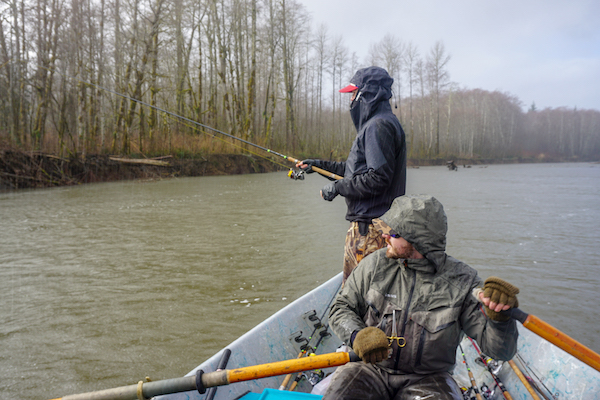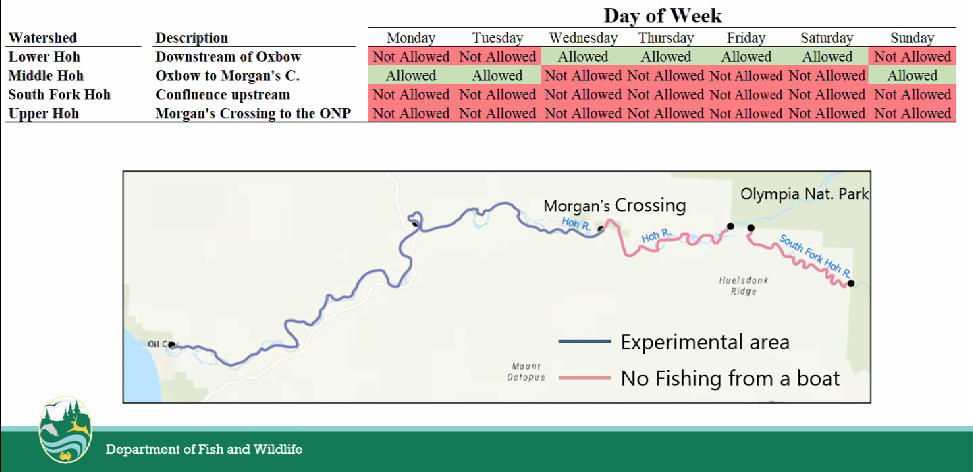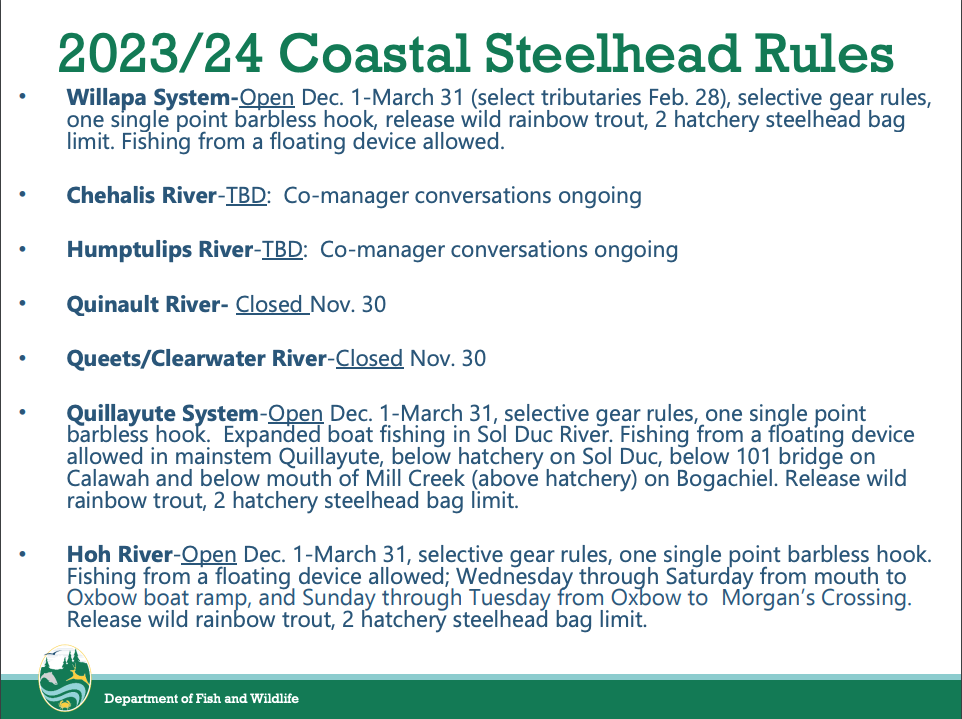
WDFW Rolls Out 2023-24 Coastal Steelhead Season Proposals
More boat angling opportunities are being proposed for this winter’s steelhead season on the Washington Coast, but the fate of Grays Harbor fisheries remains TBD.

State fishery managers are asking WDFW Director Kelly Susewind to sign off on reopening Willapa Bay tributaries and more of the Quillayute system to angling from a drift boat, pontoon or other watercraft, as well as two sections of the Hoh on an alternating schedule as part of an fishery effectiveness experiment.
The lower Hoh from Oxbow Campground to the mouth would be open for boat fishing Wednesdays through Saturdays and the glacial river from Morgans Crossing down to Oxbow would be open Sundays through Tuesdays, under proposals rolled out this evening.
WDFW’s James Losee said the objective on the Hoh is to “estimate the effect of restricting fishing from a boat on encounter rate of wild and hatchery steelhead while meeting conservation objectives.”
“I appreciate this Hoh fishery you’re looking at,” said guide Bob Kratzer.
Fellow outfitter Patric Gaffney wondered why WDFW didn’t want to try the evaluation instead on the Quillayute system, which is expected to see far more wild steelhead, but Losee said doing so there would be “extremely expensive.”
The cost of monitoring and the funding needed for it was a lowkey subplot during the nearly two-hour-long Zoom call. (See WDFW’s presentation here.)

Past seasons have shown that the lack of boat fishing cut catches by 50 percent, if I recall my ancient history correctly.
On Willapa Bay, Losee said that creel monitoring showed that angler impacts were “much lower than anticipated or estimated,” allowing for expanded boat fishing on these small streams.
However, angler Andy Darcher voiced his disapproval, saying the creel sampling there had only been done under bank fishing-only rules.
Overall, most seasons are proposed to again run through March 31, so no April opportunity, with selective gear rules and single, barbless hooks required as well. Below is the full slate of proposed rules:

Still up in the air is what if any Grays Harbor fisheries there will be this season. Conversations with comanagers at the Quinault Indian Nation are ongoing, Losee indicated, but he expressed excitement about WDFW’s bid to open sections of the Humptulips, Wynoochee, Satsop and Skookumchuck under “intensive” creel monitoring to try and prevent exceeding available impacts in an overall system that is expected to come in 1,000 or so wild steelhead under the escapement goal, a chronic problem in the Harbor in recent years.
“We worked really hard on these Chehalis and Humptulips plans. We’re really proud of them,” Losee said, billing them as “a really responsible plan that we’re proud of from a conservation perspective.”
In response to a question on December coho opportunity – available for two weeks last December – Fish Program Director Kelly Cunningham appeared to indicate that it was tied in with reaching agreement with the Quinaults on steelhead, even as the salmon fishery is written into the 2023-24 state fishing pamphlet, which came out of last spring’s North of Falcon season-setting process.
WDFW and QIN have recently disagreed over Grays Harbor coho. The nation suspended its commercial fishery early out of concern that the return was weak, but the state agency has held firm on keeping the sport season open based on its own run indicators.
Just as was presaged in last week’s Olympic National Park news release that park waters of the Queets and Quinault Rivers would be closed through next May, WDFW’s proposed regulations echo that. Last year, the park made its announcement after WDFW had set its rules, and Kratzer expressed disappointment that ONP had gotten ahead of the state on announcing coastal seasons this year, saying that it had had a “deflating” effect.
In response to a question about why the remote upper Quinault, with its 135 mortalities or 1,350 encounters available, couldn’t be opened, Losee said that given the nature of the fishery – more on top of the redds than other waters, was his eyebrow-raising claim – impacts could ramp up fast.
Looking to the long term, he said, “If we manage this right, we should be fishing the Queets and Quinault (again). That’s the objective.”
Tonight’s public meeting was the second of two on coastal steelhead seasons. The first, held in late October, saw WDFW request fishery proposals and Losee said 20-plus had been received and evaluated against the statewide steelhead management plan and desire to maintain fish abundance, productivity, distribution and diversity.
As it stands, Director Susewind is expected to sign off on final 2023-24 regs by some point on Wednesday, but discussions around Grays Harbor salmon and steelhead fisheries may continue for some period afterwards. Cunningham advised anglers there to watch the agency’s social media, news releases and website so as not to get sideways with game wardens come Friday, December 1.
This will be the fourth consecutive year of highly restricted coastal winter steelhead fisheries – including an initial blanket ban on fishing out of a boat – in response to a 30-year population decline that bottomed out to all-time lows in 2020-21. Numbers have improved somewhat, but federal managers are now mulling whether an Endangered Species Act listing is warranted.
WDFW is also requesting lawmakers give it $3.2 million to boost monitoring efforts on the coast and hopes that Governor Inslee includes it in his upcoming supplemental budget proposal. Cunningham said passing it would go a long way towards getting monitoring where it needs to be.
